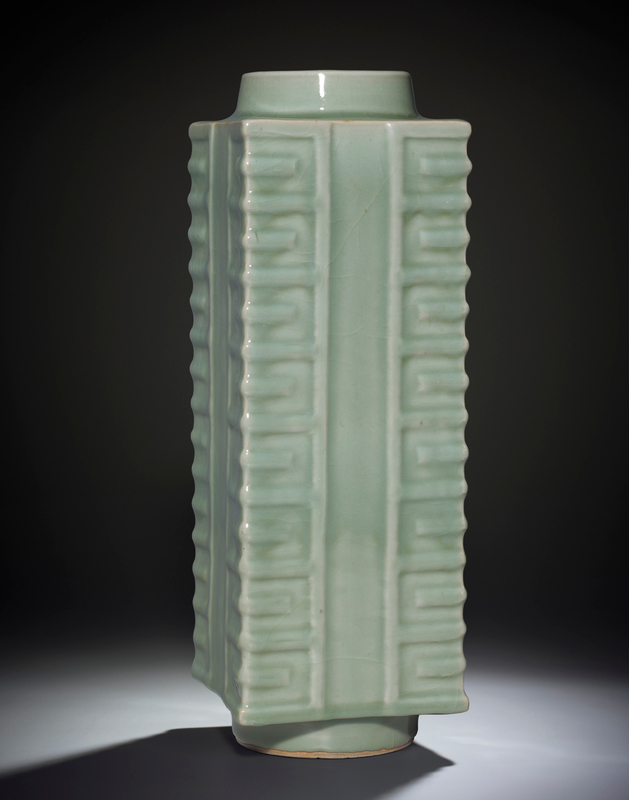Christie's. The Imperial Sale / Important Chinese Ceramics and Works of Art, Hong Kong, 28 May 2014
A very rare and large Longquan celadon cong-form vase, Southern Song-Yuan dynasty (1127-1368)
Lot 3402. A very rare and large Longquan celadon cong-form vase, Southern Song-Yuan dynasty (1127-1368); 16 1/8 in. (41 cm.) high. Estimate HKD 1,500,000 - HKD 2,000,000. Price Realized HKD 3,640,000. © Christie's Image Ltd 2014.
Made in emulation of a Neolithic jade cong, sturdily potted in square section with four rectangular facets, each moulded with alternating long and short horizontal ribs along the outer edges, leaving the central vertical panel undecorated, all between circular mouth and foot rims, and covered with an unctuous sea-green glaze thinning on the raised designs, wood stand, inscribed Japanese double wood boxes.
Provenance: One of the Japanese boxes is inscribed with 'Passed through generations originally from Toyokou', suggesting that this vase might once have been possessed by the Toyotomi family.
A Japanese private collection, Kyushu, in the 1980s
Yousaian Collection, Japan.
Note: The current vase is placed within two Japanese wood boxes. The inner red lacquer box is inscribed with 'Passed through generations originally from Toyokou', suggesting that this vase might once have been possessed by the Toyotomi family. The outer wood box bears an inscription that reads 'Song/Yuan dynasty, Longquan kiln, 41 cm. high, Certified by Mr. Seizo Hayashiya in the second month of 1979'. Seizo Hayashiya (b. 1928) is a well-known scholar on ceramics in Japan, and serves as the head of the Works of Art department at Tokyo National Museum.
The form of this vase is based on a jade cong ritual object with a circular hollow core and a square exterior. See, for example, the jade cong, dating to the Neolithic period, Liangzhu Culture, in the Nanjing Museum, included in the exhibition, China: 5,000 Years, Solomon R. Guggenheim Museum, New York, 1998, and illustrated in the Catalogue, no. 5. Such artefacts were enthusiastically collected by the educated elite of the Northern and Southern Song dynasties, prompting the production of contemporary vessels of bronze and ceramic forms based on these antique models.
The present vase is particularly rare and impressive for its large size, which, together with its square section, would have been very difficult to be fired to success. A number of Longquan celadon cong-form vases of this design and size are published, including several in renowned museum collections. A vase of similar size formerly in the T. T. Tsui Collection was sold at Christie's London, 5 November 2008, lot 393. An example in the Qing Court collection is illustrated in Porcelain of the Song Dynasty (II), The Complete Collection of Treasures of the Palace Museum, Hong Kong, 1996, pl. 97; one is included in the Illustrated Catalogue of Sung Dynasty Porcelain in the National Palace Museum: Lung-ch'uan Ware, Ko Ware and Other Wares, Taiwan, 1974, pls. 8 and 9; one is in the Idemitsu Museum of Arts, Tokyo, illustrated in The 15th Anniversary Catalogue, 1981, no. 667; one was included in the exhibition, Treasures from the Shanghai Museum: 6000 Years of Chinese Art, 1983-84, pl. XXVI; another is illustrated by R. L. d'Argence, Chinese Ceramics in the Avery Brundage Collection, San Francisco, 1967, pl. XLIV, fig. A; a larger example (41.3 cm.) in the Indianapolis Museum of Art, gifted by Mr. and Mrs. Eli Lilly, is illustrated by Y. Mino and K. Tsiang, Ice and Green Clouds, Traditions of Chinese Celadon, Indianapolis, 1986, no. 74; and another of large size in the Percival David Foundation, is illustrated by M. Medley, Illustrated Catalogue of Celadon Wares, London, 1977, no. 73.

/https%3A%2F%2Fprofilepics.canalblog.com%2Fprofilepics%2F1%2F0%2F100183.jpg)
/https%3A%2F%2Fstorage.canalblog.com%2F03%2F02%2F119589%2F96711876_o.jpg)
/https%3A%2F%2Fstorage.canalblog.com%2F11%2F31%2F119589%2F94773502_o.jpg)
/https%3A%2F%2Fstorage.canalblog.com%2F20%2F83%2F119589%2F94772815_o.jpg)
/https%3A%2F%2Fstorage.canalblog.com%2F26%2F72%2F119589%2F75604929_o.jpg)
/https%3A%2F%2Fstorage.canalblog.com%2F59%2F60%2F119589%2F26458628_o.jpg)



/http%3A%2F%2Fscontent-bru2-1.xx.fbcdn.net%2Fv%2Ft1.0-9%2F42297448_332778234158869_3600406359079649280_n.jpg%3F_nc_cat%3D0%26oh%3Daf07d5b085f86e62dd683b34927f3100%26oe%3D5C176457)
/http%3A%2F%2Fstorage.canalblog.com%2F36%2F27%2F119589%2F112998060_o.jpg)
/http%3A%2F%2Fstorage.canalblog.com%2F29%2F06%2F119589%2F112307393_o.jpg)
/http%3A%2F%2Fstorage.canalblog.com%2F69%2F06%2F119589%2F111400064_o.jpg)